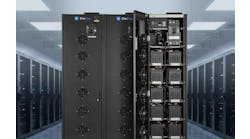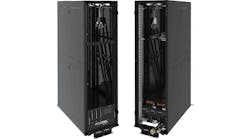The server immersion technology that has cooled extreme density bitcoin hardware for The Bitfury Group is coming to the data center. LiquidStack launched today as a stand-alone company with $10 million in Series A funding from hyperscale hardware maker Wiwynn, and ambitions to address growing cooling challenges in cloud data centers and high-performance computing (HPC).
LiquidStack says it will launch as the world’s largest liquid cooling company, with its immersion cooling systems running in 160 megawatts of high-density data centers in the Bitfury network, which processes transactions for bitcoin mining. The company says its DataTank container supports up to 252 kW of IT equipment in a single 48U rack, a density far beyond the limits of the air cooling used in most commercial data centers.
LiquidStack is born from The Bitfury Group’s liquid cooling subsidiary, previously known as Allied Control Limited (ACL), whose technology is being tested by Microsoft as an option to support higher power densities in its Azure cloud computing operation.
Wiwynn will provide $10 million in Series A funding, and a partner with deep experience working with hyperscale data center operators, both directly and through the Open Compute Project. Wiwynn has shipped systems to over 300 data centers and had $6.3 billion in revenue in 2020.
Wiwynn CEO Emily Hong said the company sees a need to address power density challenges in cloud computing and AI.
“We are excited to support and partner with LiquidStack, the leader in two-phase immersion cooling,” said Hong. “We foresee the technology widely adopted in data centers with its unmatched performance, reliability, and environmental benefits.”
Density and Flux Create Cooling Challenges
LiquidStack seeks to capitalize on the growing adoption of artificial intelligence (AI) and other high-density applications, which pose challenges for data center design and management. Powerful new hardware for AI workloads is packing more computing power into each piece of equipment, boosting the power density – the amount of electricity used by servers and storage in a rack or cabinet – and the accompanying heat.
AI hardware also can create high “flux,” in which power use in a rack increases rapidly as hardware commences a new workload, which can be difficult to manage with traditional air cooling. A number of service providers have focused on air-cooled solutions optimized for high-density workloads, but as densities rise past 25 to 30 kW a rack, users increasingly turn to liquid cooling to manage these workloads.
“We foresee the (LiquidStack) technology widely adopted in data centers.”
Wiwynn CEO Emily Hong
Immersion cooling can deliver exceptional power efficiency because it uses sealed tanks that don’t require the raised floors or room-level air cooling found in most commercial data centers. LiquidStack specializes in two-phase immersion cooling, in which servers are immersed in a coolant fluid that boils off as the chips generate heat, removing the heat as it changes from liquid to vapor. The vapor then condenses into liquid for reuse, all without a pump. This allows some LiquidStack implementations to deliver partial PUE (Power Usage Effectiveness) ratings as low as 1.02 to 1.03.
Although hyperscale and HPC loom as the largest opportunities, LiquidStack is also offering products for edge computing and 5G wireless infrastructure deployments. The company’s initial offerings will include smaller enclosures to support micro data centers, which may be particularly useful in hot and humid climates.
Innovation From the Bitcoin Sector
One of the leaders in the shift to liquid cooling has been the bitcoin mining industry, which uses powerful specialized chips to process transactions. An early innovator was Allied Control, which used immersion technology to create a 500kW data center in a skyscraper Hong Kong, which has a hot and humid climate. That got the attention of bitcoin hardware maker Bitfury, which acquired Allied Control in 2015 and used its immersion cooling in large bitcoin hashing centers around the world.
“Bitfury has been innovating across multiple industries and sees major growth opportunities with LiquidStack’s game-changing cooling solutions for compute-intensive applications and infrastructure,” said Valery Vavilov, CEO of Bitfury. “I believe LiquidStack’s leadership team, together with our customers and strategic support from Wiwynn, will rapidly accelerate the global adoption and deployment of 2-phase immersion cooling.”
The CEO of LiquidStack will be familiar to many in the data center sector. Joe Capes was previously a Global Director of Cooling Development for Schneider Electric, and general manager of liquid cooling firm Coolcentric.
“After incubating Allied Control for the last five years, we were able to build multiple hyperscale Bitcoin mining sites using LiquidStack immersion cooling while growing a strong intellectual property portfolio,” said Capes. “In 2020, we pivoted to gain market traction within the semiconductor, IT hardware, data center and telecoms segments.
“Launching LiquidStack with new funding enables us to focus on our strengths and capabilities,” said Capes, adding that liquid cooling is ready to “help solve real thermal and sustainability challenges driven by the adoption of cloud services, AI, edge and high-performance computing.”
The CTO will be Kar-Wing Lau, the founder of Allied Control. LiquidStack will be headquartered in the Netherlands, with its commercial headquarters in the USA and R&D located in Hong Kong.






